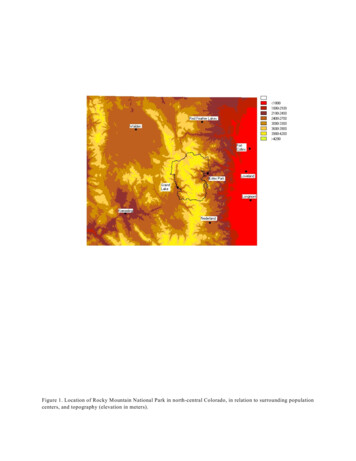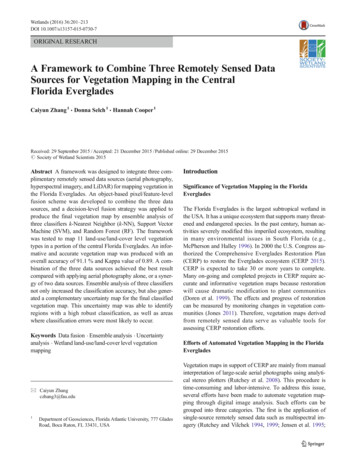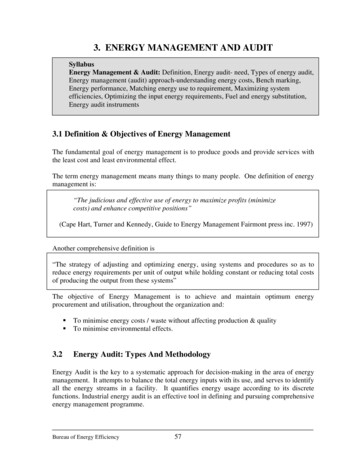
Transcription
Audit of the Vegetation Management ProgramReport # 09-04Prepared ByOffice of Inspector GeneralJohn W. Williams, Esq., Inspector GeneralJ. Timothy Beirnes, CPA, Director of AuditingDan Sooker, CPA, Chief Investigator
TABLE OF CONTENTSBACKGROUND . 1OBJECTIVES, SCOPE, AND METHODOLOGY . 3FINDINGS AND RECOMMENDATIONSExecutive Summary . 4On Hand Herbicide Inventory Should Be Reduced . 5Improve Performance Measurement Reporting. 8Office of Inspector GeneraliAudit of the VegetationManagement Program
BackgroundIn accordance with the FY09 Audit Plan, our Office completed an audit of theVegetation Management Program.The primary purpose of the vegetation management program is to ensure thatSouth Florida's conservation lands are preserved and the region's water resourcescontinue to function unobstructed by aquatic vegetation.Vegetation managementactivities primarily benefit the District-wide water resource management and regionalrestoration programs. These programs integrate mechanical, biological, herbicidal andphysical methods (such as fire and flooding) to control exotic vegetation.This image shows incontrol of cattails which hadovertaken large areas of LakeOkeechobee that were formerlyopen water. The aerial herbicideapplication managed to target the cattail but avoid non-target plants.The vegetation management program aims at attaining maintenance control overinvasive plants in canals, lakes, right-of-ways and District properties. Invasive plants arenon-indigenous vegetation that have no natural enemies, such as insects, and can oftenout-compete native vegetation because of the lack of growth restraints. There are 146invasive plant species of which 72 are considered category 1 species according to theFlorida Exotic Pest Plant Council1. Category 1 species are defined as most invasive anddisruptive.Category 1 invasive exotic plants alter native plant communities bydisplacing native species, change community structures or ecological functions, orhybridize with natives. Examples of category 1 species are melaleuca, Brazilian pepper,water hyacinth, and hydrilla. Herbicides used by the District to control invasive exotic1Florida Exotic Pest Plant Council is a not-for-profit organization that supports the management ofinvasive exotic plants in Florida's natural areas by providing a forum for the exchange of scientific,educational and technical information. The Council’s 2009 Invasive Plant List reported 72 Category 1 and74 Category 2 invasive plants in Florida.Office of Inspector GeneralPage 1 of 9Audit of the VegetationManagement Program
plants are limited to only those approved by the Environmental Protection Agency andthe Florida Department of Agriculture and Consumer Services.Maintenance control is defined as a means of applying management techniques ona continuous basis to keep invasive plant populations at its lowest feasible level. InDistrict canals, this means maintaining floating aquatic plants at less than 1% of theentire canal surface area and 50% unobstructed for submersed plants. According toquarterly performance measurement reports, the program goals are being met. Theapplication of herbicide products to control exotic vegetation is usually the most costeffective approach.The adjacent pictures of thebefore and after herbicide applicationon the C-23 canal illustrates the affectaquatic weeds can have on canalconveyanceandthesuccessofvegetation management in controllingaquatic plants with in-house staffand/or outside contractors.BeforeAfterIn FY09, the District reorganized its operations to better align resources withDistrict programs. Under the reorganization, the Vegetation Management Division andLand Stewardship Division were combined to form the Vegetation and LandManagement Department.Prior to the reorganization, both Land Stewardship andVegetation Management Divisions conducted exotic vegetation eradication separately.Now, this combined department has a staff of fifty that is tasked with controlling exoticvegetation in approximately 2,000 miles of canals and 1.3 million acres in South Florida.This combination should result in improved operational efficiencies.The primary sources of funding for vegetation management programs are theState of Florida, ad valorem taxes and trust fund revenue. For FY08 and FY09, theDistrict received 6.6 and 6.1, respectively, from the State of Florida for aquatic plantand melaleuca control programs. However, the Vegetation Management program willOffice of Inspector GeneralPage 2 of 9Audit of the VegetationManagement Program
experience substantial reductions in state funding for FY11 primarily due to the economicdownturn.Vegetation Management Program expenditures (including District staffsalaries) for the last three fiscal years were as follows:Functional AreaAquatic Plant ControlBio-controlExotic PlantTerrestrialPlant ControlExotic Plant ControlPlant udgetto Date6,713,156 3,226,659FY08Expenditures 6,756,420FY09Expenditures 5582,240,6811,498,8908,132,2102,474,156 19,458,859 19,919,4631,727,1818,945,2883,702,020 21,600,80464,0762,221,753841,876 esentapproximately 72% of the total expenditures for FY08 and FY09. For FY11, outsidecontractor participation in the vegetation management program will be substantiallyreduced.The Department coordinated with the Florida Department of EnvironmentalProtection, Florida Fish and Wildlife Conservation Commission, the United States ArmyCorp. of Engineers and local governments to implement vegetation managementactivities. Significant programs partnered with other governments include aquatic plantcontrol in Lake Okeechobee, the Kissimmee Chain of Lakes, melaleuca eradication andstocking canals with grass carp.Objective Scope and MethodologyThe objective of the audit was to determine whether the Vegetation Managementprogram is meeting its program goals and the reporting requirements are being met. Inorder to accomplish our objectives, we performed the following: Interviewed staff that manages or is active in vegetation management programs. Examined relevant documents.Office of Inspector GeneralPage 3 of 9Audit of the VegetationManagement Program
Our audit was conducted in accordance with Generally Accepted GovernmentAuditing Standards. These standards require that we plan and perform the audit to obtainsufficient, appropriate evidence to provide a reasonable basis for our findings andconclusions based on our audit objectives.We believe that the evidence obtainedprovides a reasonable basis for our findings and conclusions based on our auditobjectives.Executive SummaryThe Vegetation and Land Management program appears to be operating in aneffective and efficient manner. The Department’s burn rate is at 97% and program goalsare being met. It is also apparent that the program is a leader in the State of Florida incontrolling exotic nuisance plants.The series of photographs representApril 1998VegetationManagement’smelaleucaeradication efforts in the Pennsuco WetlandMitigation Area.February 1999In 1998, the area wasinfested with melaleuca but this sequence ofpictures illustrates the progress made inreaching maintenance control over time.October 2006The continual improvement was a result ofherbicide follow-up applications to ensurethat the area remain relatively free of exoticAugust 2009vegetation. Herbicide treatment and followup is the key to preventing exotic vegetationfrom regaining a foothold.We found that internal controls over herbicides appear adequate to ensure thatherbicide inventory is safeguarded and herbicide expenditures appear accuratelyrecorded.However, our analysis indicated that for FY08 and FY09, field stationsOffice of Inspector GeneralPage 4 of 9Audit of the VegetationManagement Program
maintained a 54-day and 59-day supply of herbicide inventory, respectively, even thoughthe annual herbicide price agreements require vendors to deliver herbicides within a 7day time frame.While having inventory available for unforeseen circumstances canprove beneficial, maintaining high levels of inventory also increases the District’s riskfrom loss or accidents. We recommend that Operations and Maintenance maintain aninventory cushion but at levels closer to the 7-day mandatory delivery time frame.We found that improvements could be made to Vegetation Management’sperformance measurement system to better report the department’s success in achievingits annual goals.Performance measurement reporting should clearly communicatewhether the department is or is not meeting the programmatic goals and objectives. Werecommended that the department establish performance measurements that bettercommunicate the department’s success in meeting its goals and objectives.On-Hand Herbicide Inventory Should Be ReducedWe found that internal controls over herbicides appear adequate to ensure thatherbicide inventory is safeguarded and herbicide expenditures appear accuratelyrecorded. For all field stations the herbicide building is locked and has a keypad alarmsystem. The common practice at District field stations is for the Storekeeper to haveaccess to the herbicide building.Keys to the herbicide building are issued to thestorekeepers and the Director and another field station manager.The PurchasingTechnician and Administrative Assistant are usually backups to the Storekeeper when theStorekeeper is away from the field station.The Director and another field stationmanager also have keys to the herbicide building. At one of the field stations, theherbicide building has a locked caged area where the herbicides are maintained.Herbicide buildings are monitored by Security at the B-1 building headquarters in WestPalm Beach, Florida.The SAP inventory account is updated when herbicides are ordered and received.Adjustments to the inventory account are made when Storekeepers issue herbicides toDistrict vegetation management staff and outside contractors and record the herbicideOffice of Inspector GeneralPage 5 of 9Audit of the VegetationManagement Program
quantity issued and returned to SAP inventory and budget accounts. Returned herbicideis restocked and the SAP system is updated for the estimated amount of the unusedportion of the herbicide.To reorder herbicides, the Storekeeper completes a purchase requisition andforwards it to the Field Station Purchasing Tech who prepares a purchase order andalmost always assigns it to the lowest bidder that responded to the District’s annualrequest for bid (RFB) for herbicide unit pricing. On an annual basis, the District issues aRFB to obtain the best pricing for the most used herbicides. Those vendors offering themost competitive herbicide pricing are awarded one-year price agreements.However,the Purchasing Tech may use any vendor to purchase herbicides if their price is better andis not compelled to only use vendors who responded to the RFB and initially provided thebest unit pricing.We reviewed herbicide purchases for the audit period and noted one instance inwhich the Purchasing Tech did not use the vendor awarded the price agreement for theherbicide, glyphosate. Initially, this incident appeared to be an internal control weaknessbut further review of the transaction revealed that the Purchasing Tech purchased theherbicide for considerably less than the agreement unit price and saved the District asubstantial amount of money.Field station Crew Chiefs usually determine the herbicide quantities needed. Atfield stations there is no formal method for reordering herbicides and it is generally basedon judgment (i.e. observation and anticipated workload). In our previous audit of theVegetation Management program dated July 6, 1999, Operations and Maintenance agreedto keep inventories at 45 days or less except in unusual circumstances.Office of Inspector GeneralPage 6 of 9Audit of the VegetationManagement Program
Our analysis2Herbicide Inventory UsageFY08FY09 529,486 471,523Ending Inventory471,523328,459Average Inventory 500,504 399,991 3,346,867 2,457,906Inventory Turnover Ratio36.96.1Number of Days in Inventory5459DescriptionBeginning Y09,stationsmaintained a 54-dayand 59-day supply ofherbicide inventory,respectively,eventhough the annualherbicide price agreements require vendors to deliver herbicides within a 7-day timeframe.Unexpected weather conditions such as wind and rain can affect the sprayingcrews work plan; however, the average number of days in herbicide inventory appearsconsistently high. While having inventory available for unforeseen circumstances canprove beneficial, maintaining high levels of inventory also increases the District’s riskfrom loss or accidents. Moreover, management’s pledge to reduce inventory levels to 45days appears insufficient when considering the 7-day vendor herbicide deliveryassurance.As such, we recommend that Operations and Maintenance build in aninventory cushion but maintain inventory levels closer to the 7-day mandatory deliverytime frame.Physical counts of herbicides are performed annually by Operations andMaintenance and Accounting personnel independent of the stores and aquatic weedoperations.A review of inventory records indicated that there has been no majorphysical count to book adjustments.In addition, our discussion with Field StationStorekeepers revealed that informal physical counts of herbicide inventory are conductedat least monthly.23Herbicide usage represents the amount of herbicides used by District field station spray crews.The inventory turnover ratio tells how often inventory turns over during the course of the year.A high inventory turnover ratio is generally positive.Office of Inspector GeneralPage 7 of 9Audit of the VegetationManagement Program
Recommendation1.Establish an inventory reordering system that reduces the number of days ofon-hand herbicide inventory levels closer to the mandatory 7-day deliverytime frame.Management Response: Agree. The Vegetation and STA Management Divisionwill work closely with each field station to develop and implement an herbicideinventory process that will accommodate the needs of all Field Stations. We arerecommending keeping the inventory levels at 30 days. This will allow forunforeseen schedule changes between the time herbicides are purchased and thetime of application.Responsible Department:North, Central and South Field Station Department,Vegetation and Land Management Department.Estimated Completion Date: January 1, 2011Improve Performance Measurement ReportingWe found that improvement could be made to Vegetation Management’sperformance measure system to better report the department’s success in achieving itsannual goals. While the goals and success indicators in the District’s strategic plan arewell defined, performance measurements which evaluate the success in meeting thosegoals are less defined. Performance measurement reporting should clearly communicatethat the department is or is not meeting the programmatic goals and objectives.According to the Vegetation Management Plan, the overall success indicator is toachieve maintenance control in Lake Okeechobee, District canals and other water bodies.Maintenance control is defined as maintaining floating aquatic plants at less than 1% ofthe entire canal surface area in District canals and 50% unobstructed for submersedplants. However, current performance measurements merely establishes the number ofOffice of Inspector GeneralPage 8 of 9Audit of the VegetationManagement Program
acres to be treated for exotic vegetation infestation which may or may not translate intomeeting the goal of maintenance control for Lake Okeechobee, District canals and otherwater bodies.For FY11, maintenance control goals and objectives may be difficult to achieve.The Vegetation Management program will experience substantial reductions in state andoverall program funding for next fiscal year.As a result, the program is eliminatingoutside herbicide application contracts in FY11, which will likely have an adverse affecton vegetation management control ementsthatbettercommunicatethedepartment’s success in meeting programmatic goals and objectives.Management Response:Agree.The Vegetation Management and STADivision has been working on revising the Division’s performance measures tobetter align with our current annual work plan and processes. Improvedperformance measures will better communicate if we are meeting theprogrammatic goals and objectives of the Department.Responsible Department: Vegetation and Land Management Department,Vegetation and STA Management Division.Estimated Completion Date: January 1, 2011Office of Inspector GeneralPage 9 of 9Audit of the VegetationManagement Program
Vegetation Management's melaleuca eradication efforts in the Pennsuco Wetland Mitigation Area. In 1998, the area was infested with melaleuca but this sequence of pictures illustrates the progress made in reaching maintenance control over time. The continual improvement was a result of herbicide follow-up applications to ensure











